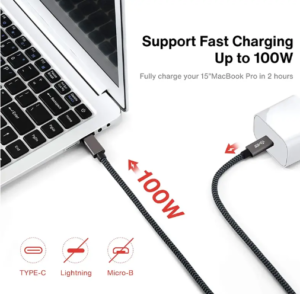
USB4 Cable Specifications: The Future of High-Speed Connectivity
Introduction As technology continues to evolve, the demand for faster, more efficient connectivity solutions has become critical for businesses and
The first thing most people ask themselves when they are researching the topic of fiber optics vs copper cables is “what’s the difference?” The simple answer is – both cables carry electronic signals over long distances, but they do so in different ways. Copper wires use electrical impulses sent through a wire made out of metal (usually copper). Optical fiber cables use light to transmit information.
The main difference between the two lies in their data transmission. Fiber optic transmission uses beams of laser light, whereas copper cables rely on electrical impulses sent through a wire made out of metal (usually copper). In addition to this, there are many other differences that help define and distinguish these cable types from each other:

Bandwidth refers to how much data can be transmitted through a given medium per unit time. Fiber optic cables have much greater bandwidth than their counterpart copper cables due to their structure – light signals are sent through an optical fiber by modulating the intensity of the light beams that pass through it instead of sending electronic signals over wires using electrical charge flow. Since there is no electrical charge flow in fiber optic cables, they can be manufactured to have extremely small diameters. As a result, high-speed data can be sent over very long distances without attenuation (the loss of signal strength that occurs when a signal travels through a medium that impedes its progress). This is why internet services such as Facebook or Netflix that need to transmit large amounts of information from one location to another almost always use fiber optics for their backbones instead of traditional copper cables. In contrast, most forms of current-day communication technologies use electronic signals rather than light signals since electronics are more stable and require less complex hardware to process and transport them. For this reason, copper cables still play an integral role in many applications where bandwidth isn’t as important as it is for long-distance communication, such as in telephone lines and home networks.
Fiber optics is more secure than copper cable. Because it doesn’t use electrical impulses, there is no way for an outside source to intercept data transmissions over fiber optic cables. For this reason, the government and many businesses rely on fiber optics for sensitive information such as personal records and financial reports.
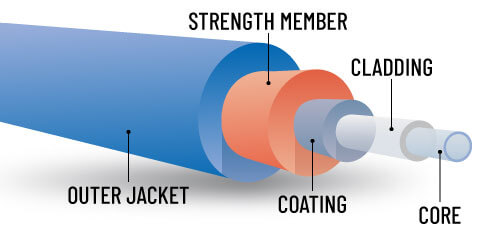
Both fiber optic and copper cables have their pros and cons in terms of durability, but the copper wire has a shorter lifespan than optical fiber cable. Optical fibers are very resistant to corrosion and are able last about 10 times longer than copper wire (over 75 years vs 7 years). This is why fiber optic cables are often found in areas like the ocean where it is exposed to saltwater. Fiber optic cable is usually made from glass, which means it can be manufactured to very thin diameters. This makes the fiber optic cable extremely flexible, so it is easy to bend without breaking. However, a large amount of force can still damage a fiber optic cable by cracking or even shattering the glass tube. To combat this problem, optical fibers are often protected using Kevlar threading that holds the glass together if it breaks. This allows the fiber optic cable to withstand moderate amounts of force before being damaged beyond repair. In contrast, the copper wire must maintain a certain thickness in order for signals to travel through it effectively – otherwise, the wire will heat up, expand, and eventually melt. This means copper cables are usually bulky and not very flexible. The thicker diameter of copper cables also makes them better suited to withstand large amounts of force. However, if a copper cable is sharply bent or crushed, it can easily be damaged beyond repair since the metal is soft enough to bend easily.

Fiber optics is more expensive than copper cable. Since fiber optic cables last longer and can transmit up to 10 times the information, it costs more money for businesses to use them. Some companies feel that the cost is worth it because of all of the benefits that come with using these cables but others choose to use less costly options like copper wire instead.
In addition to its superior performance, fiber optic cable is also more durable and can last longer than copper. This makes it a more cost-effective option in the long run. Copper cables tend to corrode and degrade over time, while fiber optic cables can withstand a great deal of wear and tear.
Both fiber optic and copper cables have their own unique manufacturing processes, but both share some similarities as well. Fiber optic cable is made by first creating a hollow glass tube. A thin metal wire is then wrapped around the glass tube, and the two are heated until the wire fuses to the glass. This creates a cable that can transmit light signals over long distances.
Copper cable is made by drawing copper wire into thin strands. These strands are then twisted together to create a cable. Copper cables are often coated in plastic or other insulation to protect the wires from corrosion and other damage.
There are three main types of fiber optic cables: single-mode, multimode, and plastic optical fiber. Single-mode fiber optic cables are made of glass and can only carry a single beam of light, which makes them perfect for long-distance applications. Multimode fiber optic cables are made of plastic and can carry multiple beams of light, which makes them perfect for short-distance applications. Plastic optical fiber is made of plastic and can carry a single beam of light, which makes it perfect for short-distance applications.
Copper cabling is of three main types: twisted pair, coaxial cable, and ribbon cable. Twisted pair cables consist of two wires twisted together to protect them from crosstalk, which is interference between the pairs. Coaxial cables have a center wire surrounded by insulation, which has an insulating sheath surrounding it. Ribbon cables consist of multiple insulated wires running parallel next to each other.
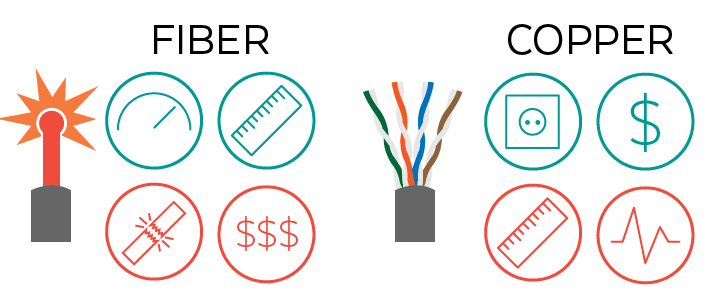
Fiber optic cable is made up of thin strands of glass that are insulated by a coating of plastic. When light is passed through these strands, it is transformed into data that can be transmitted over long distances. Because the glass fibers are so thin, they are not affected by electromagnetic interference or electrical fields. This makes fiber optic networks ideal for transmitting data in areas that are susceptible to interference, such as power plants. Also, fiber optic cables allow existing electrical and communication infrastructure to be maintained since they can run through the same conduits as other wiring. The downside of fiber optic cable is its high cost compared with copper cable. Despite this high initial cost, fiber optic is becoming more popular due to its advantages over other types of cables.
Copper cable is a type of electrical cable that is used to transmit data at high speeds over short distances. While it has been standard for many years, as technology continues to advance and data needs to be transmitted at higher speeds and across longer distances, there are issues with using copper cable. Data signals sent through copper can experience interference from environmental factors such as lightning strikes and radio waves, which makes it difficult to maintain high signal integrity without amplifiers or repeaters between sending and receiving devices. However, despite these drawbacks, due to its low cost and ease of installation compared to fiber optic cable, it is still widely used in many telecommunications applications today.
In conclusion, it is clear from this article that there are many advantages to using fiber optic cables instead of copper ones, especially in high-intensity areas where there is a lot of radiofrequency interference. While fiber optic cables are more expensive initially than their copper counterparts, they will help lower long-term costs as well as maintenance expenses since they do not need to be replaced as often. Additionally, fiber optic cables can carry data much further and at a faster speed than copper ones. Therefore, if you are looking for a reliable method of transmitting data without interruptions or disruptions in service, fiber optic cable is the way to go. Even better is the fact that top manufacturers like Edom Electronics can designs fiber optic cables that are specific to your needs. Send them your inquiry and their experts will be able to find a solution for you.

Introduction As technology continues to evolve, the demand for faster, more efficient connectivity solutions has become critical for businesses and
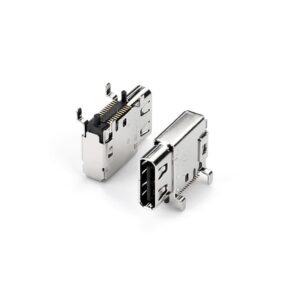
Understanding the Evolution of USB Connectors In today’s technology-driven world, USB (Universal Serial Bus) connectors are an integral part of
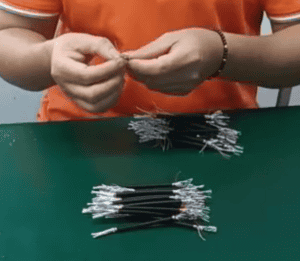
At EDOM Electronics, we take pride in our meticulous approach to manufacturing high-quality USB C to C cables. Today, we’re
WhatsApp us
